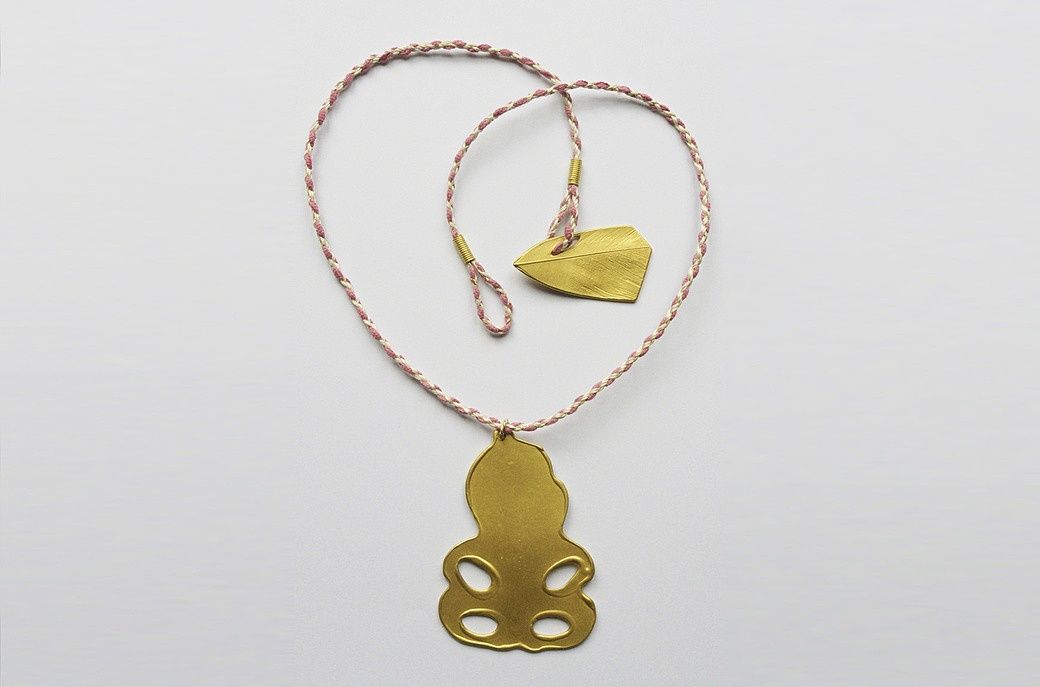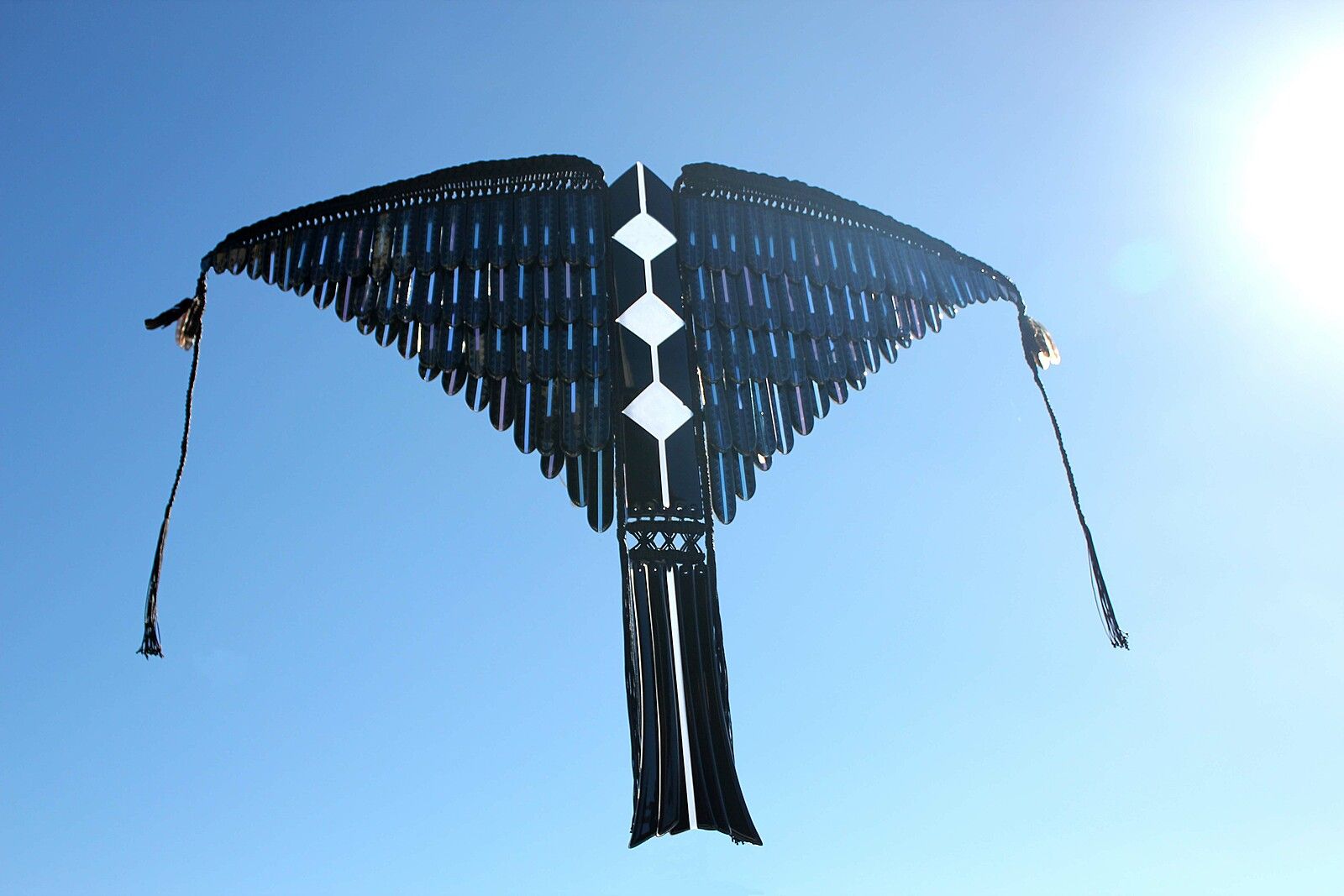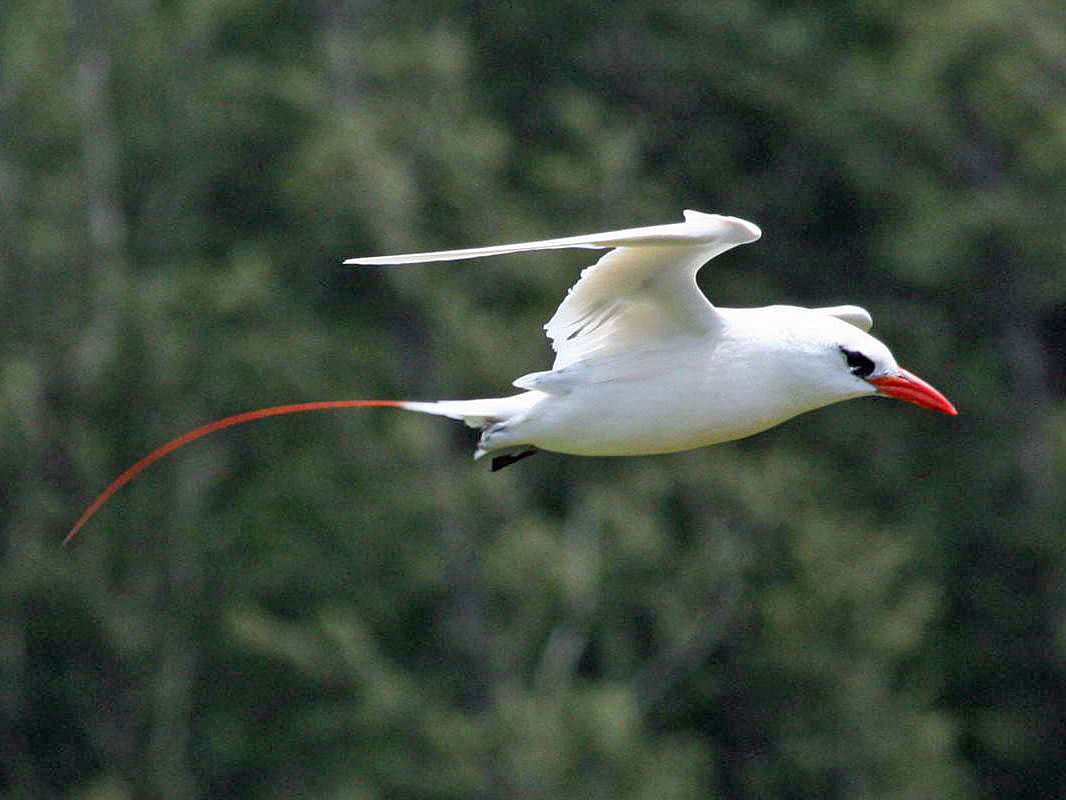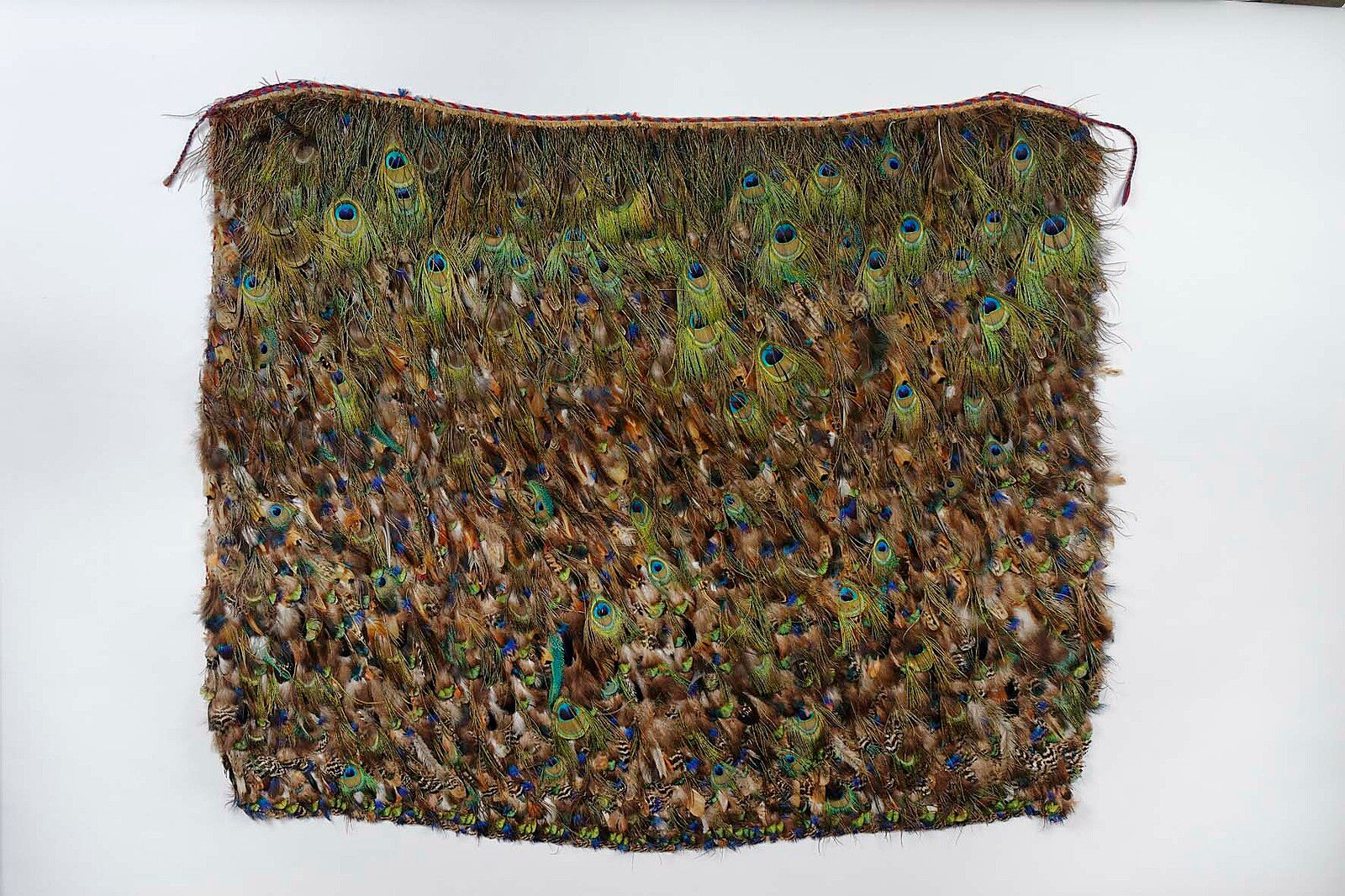Kōrero Mai, Kōrero Atu: On making an exhibition from colonial spoils
Janneen Love on curious encounters with a forgotten bird and on making Auckland Museum's Kōrero Mai, Kōrero Atu, an exhibition that refuses staid historical retellings of a culture that's very much alive and thriving.
Janneen Love on curious encounters with a forgotten bird and on making Auckland Museum's Kōrero Mai, Kōrero Atu, an exhibition that refuses staid historical retellings of a culture that's very much alive and thriving.
It began the morning we all met for the first time as a collective. We – Areta Wilkinson, Te Rongo Kirkwood and myself, the exhibition developer – started the morning in the Museum café. The day dawned with the news that Manos Nathan, senior Māori artist, co-founder of Ngā Kaihanga Uku, mentor, and friend to us all, had passed away. It was with heavy hearts that we began to move through the Museum’s collection stores and galleries, discussing ideas about the exhibition kaupapa or concept, our respective relationships to this museum and these collections, and the influences these have had on us. We were discussing the objects, museum practice and creative processes that would best represent our ideas, at the same time as opening doors all over the Museum, and meeting staff from multiple collection areas and disciplines.
Like many Māori artists, Areta and Te Rongo are at the forefront of creative adaptation, using a palette of materials that doesn’t comfortably fit into what some consider to be customary Māori materials. They both make taonga or works that, like many of the collections housed in this Museum, accumulate stories that will transcend time and reinforce whakapapa, both physical and metaphysical.
Areta Wilkinson is a respected and accomplished artist, contemporary crafts practitioner and academic, who has had a long association with the Auckland War Memorial Museum. Our collections and expertise have been an important research tool in the development of her practice; conversely, the Museum has over the years acquired a number of her works. Areta completed her doctoral thesis in 2014, and in 2015 was awarded the Creative New Zealand Craft/Object Fellowship. She makes exquisite and thought-provoking jewellery to adore, and in this exhibition is testing new objects she has made in response to items in the Museum’s collection.
Te Rongo Kirkwood, too, has a long relationship with the Museum, including a biographical connection through her uncle, Te Warena Taua, who was an ethnologist here in the 1980 and 1990s. She is an artist who works primarily with glass, a material that requires scientific precision and equipment to manipulate. She has worked collaboratively with Māori weavers to create specific cultural items, kākahu or cloaks. She is pushing boundaries with her collaborative approach and her technical abilities. The Museum’s kākahu collection has been a significant influence for Te Rongo, and the presentation of these taonga alongside her work looks to explore this relationship. Her series of four kākahu, Ka Awatea, has just returned to Aotearoa New Zealand from an international tour. Their exhibition at the Auckland War Memorial Museum provides a moment of reflection and completion (of a sort) to a cycle.
It was on this day that the amokura first appeared, seemingly waiting to have a conversation. We were with conservator Kararaina Te Ira who was softly brushing dust off feathers attached to a board. We all moved around her workstation, asking: what are these? The answer: the improbable tail feathers of the amokura, or red-tailed tropicbird, Phaethon rubricauda to give the scientific name. Not common to the New Zealand mainland, yet here they are in the Taonga Māori collection, in abundance.
Later in the day Areta and I moved upstairs, to the Natural History collection areas. She was interested in looking at moa bones from a site she was familiar with, to discover if these bones had been processed (butchered) by humans. The search didn’t pan out, but while we were there I took the opportunity to ask Jason Frogget, a collections manager in the Natural Sciences Department, about amokura. He opened the storeroom doors and we were shown the study skins. Here they appeared again, the same bird in the same building, but separated by vast distances of different forms of knowledge and perspectives. Strong easterly gales occasionally bring the amokura to the mainland, but this is rare. They are pelagic seabirds, rather irregular unassimilated migrants. I am struck by the way they are separated by the curious taxonomy of the Museum. In the natural history database we find 53 listings for amokura ‘specimens’, including eggs, clutches, study skins, bones and feathers.
It is a real privilege to shadow artists when they are exploring the Museum’s collections, and working with Te Rongo and Areta has been an exceptional opportunity. Our respective visits to the storerooms have provided me with an excuse to investigate the Museum collections and I have enjoyed the tangents and intersections the conversations take. I have become acquainted with objects, led by a curiosity of materiality, aesthetics, technique, personal relationships and emotion. As someone who has worked here for a number of years, my view has shifted because of this project.
It’s not a new idea for artists to partner with museums. Collaborations with artists provide a museum with different ways of sharing the collections it cares for. For artists, a museum collection offers a chance to investigate technique, materials and whakapapa – an exploration of interconnection, from genealogy and other cultural dimensions, to relationships that fall into the realm of natural science. For both the museum and its visitors, these collaborations can offer a new and interesting experience, and present different types of exchange.
This all comes with a caveat. Involving artists in the mix can trigger some anxiety for a museum. With competition for resources, and the attention of museum staff members already claimed by other duties, there is at times apprehension about what such collaborations will bring. Museums are interested in the social and scientific context of objects, the way they represent technologies, methods and materials, and sometimes their aesthetic qualities. They have very defined ideas about how objects should be displayed, and what should be said about them. Museums are also in the business of preservation and conservation; to handle objects without gloves is rare. A museum cannot be sure of the outcomes when working creatively with artists to produce an exhibition.
For artists, too, there is a certain amount of fear or apprehension. A museum might misunderstand, under-represent, and overexplain their works and artistic intentions. How an art gallery and a museum talk about objects, let alone display them, can be quite different, something that is only magnified when it comes to contemporary art. A museum’s attempted democratic approach to information, and its awareness of an audience that has not come principally to see art, can lead to wall texts and interpretation strategies that don’t sit well with art conversations. The way these two artists have researched the Museum’s collections crosses boundaries and museum disciplines. It disrupts regular approaches; for example, while the outcome of their work is quite different, there is a distinct similarity in the importance of mātauranga Māori in their respective processes.
A museum’s attempted democratic approach to information, and its awareness of an audience that has not come principally to see art, can lead to wall texts and interpretation strategies that don’t sit well with art conversations.
The creative practices of Areta and Te Rongo have shaped how visitors are invited to experience the Museum’s collections. Through their contributions to the project, a harmony has been established which influences the way the exhibition has been presented. This in turn is captured in the exhibition title, which signals a way of working. Kōrero mai kōrero atu: talk to me, to us – talk to others.
As our project develops I am distracted by the amokura. I continue to investigate.
In 1928, on behalf of the Auckland War Memorial Museum, Mr HE Vaile (president of the Auckland Institute and Museum from 1926 to1931) presents Princess Te Puea with a gift of both huia and amokura feathers gifts that ‘evidently pleased her very much’.[1] At Parliament House in Wellington in 1927, Māori from Hāwera wearing amokura feathers visit Prime Minister Gordon Coates, and Minister of Native Affairs Sir Māui Pōmare. In his address the Prime Minister states, ‘It is unnecessary for me to remind you, of the willingness and desire on the part of New Zealanders to help you progress, to develop your lands and your arts, and to retain all those desirable customs that our ancestors remember having seen when they first came to the country.’[2] The visiting party of Māori then give to the official government party the amokura feathers, mats and poi.
In 1900 James Cowan observes Māori from Rotorua decorating their hats with these ‘peculiar’ feathers, and notes that Māori call them ‘tohu rangatira, a sign of chieftainship’.[3] He also noted that Māori are wearing an imitation of the amokura feather made from dried and woven maurea, a slender grass found near Lake Taupō. Curator of Botany Ewan Cameron and I look at historic specimens in the Museum’s herbarium. We find a distinct red grass, Cyperaceae Uncinia rubra, that was collected by William Colenso on the plains near Lake Taupō. Colenso sent this specimen to botanist Thomas Cheeseman, also the musuem’s director at the time. We speculate this is the plant woven to impersonate the amokura feather. Even though the specimen is well over 100 years old, it still has distinct hues of rouge.
Three amokura feathers collected by Ngāpuhi chiefs are traded for a valuable slab of greenstone by a Hawke’s Bay chief, demonstrating the value that these objects have for Māori in the nineteenth century.[4] I take a moment with artist Maureen Lander, a weaver and academic, at the Pacific Arts Association conference held at the Auckland War Memorial Museum. She directs me to a mōteatea about the amokura, and I find ‘He waiata na parearohi’.[5] She speaks about the significance of these birds for Ngāpuhi, and for northern rangatira. We ruminate on how auspicious it is, the surfacing of these amokura feathers on the day after Manos Nathan passed away. I am ensnared.
Tera te komaru kia ata haramai,
Kia ata whangaia taku nei titiro;
He ao uru pea, e takahi rawa
Puia manuka ki te hoko tirange
Maru tata rawa 'hau
Te wa ki Nukupori,
Kia Te Heiraura,
E moea iho nei.
Kia tia taku rangi
Te rau o te amokura,
Tikapa o te rangi,
O konuku te ra,
He pakinga ratahi,
Ka whanatu ai au, e!
That mist yonder drifts hither slowly,
Prolonging the feasting of eyes upon me;
'Tis perhaps, the heavy mist that comes
From the ti tree bower where my people gather
And to which I am soon to return
Following the pathway to Nukupori,
'Twill then be, O Heiraura,
You I will see only in dreams.
So let me adorn my head
With the plume of the amokura,
While the sun is overhead,
Soon it will quickly decline,
This then is a last farewell
Ere I depart, alas!As dictated by Ngakuru Pene Haare
Various Māori concepts at play in this exhibition are reflected in the imagining, development and delivery of the exhibition. The project team has been conscious of the role of the kaihanga, the makers of works known and unknown; of whakapapa, a taxonomical framework that connects or charts relationships, genealogical and evolutionary, and how this framework links objects and people; of mana taonga, the intrinsic ability for objects to communicate multiple meanings, across time and over generations. Taonga in this context also have the facility to reflect ideas about identity, technology and exchange, particularly for people who have a shared whakapapa, or develop a connection.
It also a wider principle of the Museum to express manaakitanga, hospitality that ensures we treat our manuhiri, our visitors, both respectfully and with a deep consideration of their needs and mana. These concepts have risen to the surface at many points during the exhibition process, affecting how the team has operated, the methods of display, and the interpretation strategies. This is how this museum continues to uphold its commitment as kaitiaki, caregivers or guardians, of its collections.
It is all an intellectual exercise, until you consider the Museum’s visitors and set about the task of developing and building an exhibition like this. The Auckland War Memorial Museum has approximately 850,000 visitors a year, and they come from all over the world. Museums are expected to provide access to both the collections they care for, and the information that surrounds them, to provide context for the objects and weave this into digestible bite-sized exhibits. Here, for the most part, the artists’ work, the art, is the conversation; it speaks for itself. And as a result, this exhibition finds itself somewhere in the middle, heading into new territory as it acts a little more like an art gallery while the exhibition is on. The artworks provide a catalyst for exchange: an exchange of ideas, memories, emotions and whakapapa. Māori art becomes part of a continuum, a presentation of a culture that is alive, and thriving. This is contradictory to many museum exhibits.
Māori art becomes part of a continuum, a presentation of a culture that is alive, and thriving. This is contradictory to many museum exhibits.
In the case of Kōrero Mai, Kōrero Atu, both the Museum and the artists have embraced the uncertainties and explored connections and opportunities. The narrative structure (the stories and experience we are sharing) comes from a different starting point to that of a familiar museum display. The exhibition dovetails the collections, and the way they inform an artist’s research methods, and creative process, integrating a kaupapa Māori conceptual framework. In turn, artistic approaches inform new ways of thinking about museum collections, new forms of knowledge and exchange. These can come from a place of emotion, from a personal relationship, or a critique of past museum practices. These two artists, with a fluid application of distinctly Māori cultural concepts, encounter the collection in works they have previously made, and in new works made especially for this exhibition.
In Aotearoa New Zealand, Māori is a culture that has been colonised. This museum is the home to many of the resulting colonial spoils. When indigenous researchers, artists and scientists engage with museum collections on their own terms they can re-establish, revive and reignite cultural practices, relationships and technologies. Artist-led investigations can expose stories and connections not usually considered by a museum, and provide insights into makers and wearers of times gone by. In this regard taonga Māori collapse time; the space of our ancestral intent comes closer to us traversing different way of seeing and sharing the Museum’s collections.
The encounters with amokura represent, for me, a personal sample of the connections that this exhibition embodies on a larger scale. New connections, like that of the amokura, start to reveal whakapapa, illuminate unexpected information, create opportunities for exchange: for human history, natural science, and creative disciplines to generate new insights into the who and how of our history.
This essay is from the Kōrero Mai, Kōrero Atu exhibition programme
Kōrero Mai, Kōrero Atu
is at Auckland War Memorial Museum Tāmaki Paenga Hira
Special Exhibitions Hall
30 June - 11 September 2016
Free with Museum entry
[1] ‘Gifts to museum’. 1928. New Zealand Herald. 13 October, p. 14.
[2] ‘Ceremonial greeting: Maoris return thanks’. 1927. New Zealand Herald. 7 June, p. 12.
[3] James Cowan. 1900. ‘Our New Zealand birds’. New Zealand Illustrated Magazine 1 (8): 631.
[4] RA Falla. 1936. ‘Maoris and the birds’. New Zealand Herald. 11 April, p. 10.
[5] ‘He Waiata Na Parearohi’. 1955. Nga Moteatea, supplement to The Journal of the Polynesian Society, part 1, 64: 90–152.





